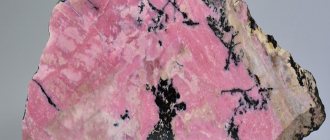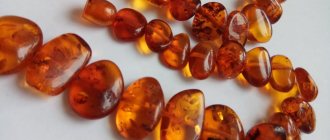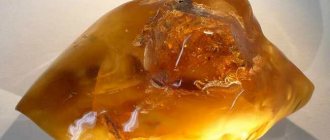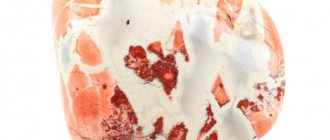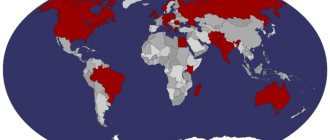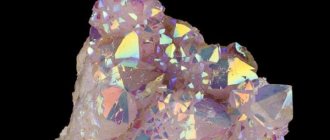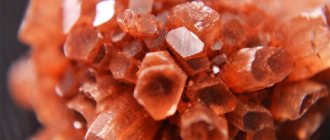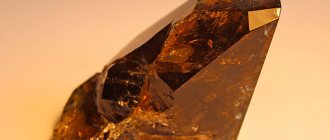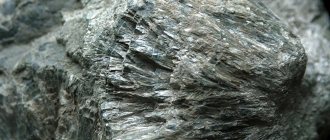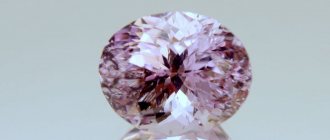The rock-forming mineral orthoclase, despite the fact that it is not a precious stone, is endowed with important characteristics: an attractive appearance, healing and magical properties. And although this crystal has been known to mankind since ancient times, the scientist A. Breithaupt first provided the world with a description of the stone in 1823. Now orthoclase is used in construction, medicine and the ceramics industry.
What is
Orthoclase is a type of feldspar, the most common stone on the planet.
Rock-forming mineral of nepheline syenites, hornfels, pegmatite veins.
It has different, but not flashy, shades and degrees of transparency.
Samples with fluorescence – bluish or orange – are especially valued. This is how faceted orthoclase shimmers in the sun or in the light of the full moon.
History of discovery
The mineral appears in sources dating back to the first millennium. The official history begins in the 19th century. In 1823, German mineralogist Johann August Friedrich Breithaupt created a scientific description and coined the name of the stone.
The term “orthoclase” has ancient Greek roots: ὀρθός - straight, κλάσις - crack. This is how the main characteristic of the mineral was displayed - cleavage at right angles between the planes.
Because of it, orthoclase breaks into cubes.
Physico-chemical characteristics
From a chemist’s point of view, orthoclase is a conglomerate of silicates (potassium, silicon, aluminum, sodium) with a formula typical for this class.
For a mineralogist, this is a stone from the alkali feldspar group.
| Formula | K(AlSi3O8) |
| Color | glassy gray (sanidine), light yellow, pink to meat red (orthoclase), colorless (adularia), yellow, reddish (sunstone), bluish (moonstone). The coloring is often uneven and spotty. |
| Stroke color | White |
| Shine | glassy, pearlescent on the cleavage planes. |
| Transparency | the mineral, translucent along the thin edge, is opaque. Some varieties can be translucent or even transparent. |
| Hardness | 6 |
| Cleavage | perfect in one direction, average in the other, the angle between the cleavage planes is 90°. |
| Kink | uneven, or stepped, along the cleavage. |
| Density | 2.56 g/cm³ |
| singonia | Monoclinic |
We recommend: GYPSUM - all around us
The crystals are shiny, transparent until translucent.
Most often colorless. Impurities of sodium, iron, barium, rubidium, and calcium in the composition create shades of other colors.
Mining locations
Orthoclase is found in volcanic deposits, granitic and metamorphic rocks.
Raw materials are mined in the USA, Scandinavia, Madagascar, and Sri Lanka.
Russian production regions - Khibiny, Ural.
The material of different deposits differs:
- Stones from Sri Lanka are identified by blue adularescence.
- Semi- or fully opaque pastel colored gemstones with a lunar effect or a cat-eye stripe are supplied by India.
- Yellow, golden orthoclase comes from Madagascar.
- Transparent sea-green feldspar melts from African pegmatites (Zimbabwe). It is passed off as aquamarine.
- Sources of sanidines are the USA and Germany.
In the Alps on the Swiss-Italian border, adularia are still mined.
Place of Birth
The mineral is mined in different parts of the world.
The description of stone from different deposits differs in color and composition:
- The main supplier of jewelry stone is the “gem triangle of Southeast Asia” (Myanmar-Sri Lanka-India).
- Large deposits are located in Austria, the Czech Republic, Germany, Kyrgyzstan (in the Pamirs), Mexico, and the USA.
- Madagascar is famous for its transparent yellowish specimens.
- Orthoclase is mined in Australia, Italy, and Brazil.
In Russia, the stone is mined in the Urals (Ilmenskoye and Vishnevye mountains). Jewelry-quality specimens are supplied by Transbaikalia, Khabarovsk Territory and the Kola Peninsula.
Varieties
Classic, “pure” orthoclase is a stone of yellowish, pinkish or red meat shades.
Mineralogy
Mineralogical science recognizes the following varieties of orthoclase:
- Adularia . A colorless, transparent mineral of medium gloss. Not particularly popular with jewelers. Purchased by collectors of mineralogical collections.
- Moon rock . The purest of orthoclases with a delicate bluish tint. It is created by the structure of the mineral: alternating layers of albite and orthoclase. Thanks to this, light rays are refracted, creating a “moonlight” effect. The most beautiful and valuable jewelry variety of orthoclase.
- Sanidin . Colorless or pastel shades - from beige to brown minerals. They look like glass interspersed with tables. The flickering of the stone in the light is their merit.
- Sun stone . Transparent golden or yellow orthoclase. The color is created by the dominance of iron in the composition. It is distinguished by its red-yellow iridescence. After cutting, it acquires a golden shine, which is why we love it among jewelers.
Moon rock
According to some classifications, adularia and moonstone are one and the same.
The name of the variety and color is present in the description of the stone.
Jewelers
Jewelers have their own classification of mineral types - by color:
- Watery - colorless.
- Lennilit is green.
- Ferriorthoclase is yellow.
- Erythritol is red.
Crystals with iridescence of pearl-gray tones are called “wolf’s eye”.
Other names for orthoclase in different shades: fish eye, hyalophane, ice spar.
We recommend: OBSIDIAN - devil's claw, Apache tears
Origin
Igneous, post-magmatic and metamorphic origin. It is found in acidic igneous rocks: gneisses, granite pegmatites, syenites. Rarely found in greywackes and arkoses. The outline, especially in porphyry phenocrysts, is tabular or elongated. In intrusive rocks they are usually irregular in shape.
Sizes vary, from small microliths to large individuals up to several meters in diameter. A glassy, water-transparent variety of orthoclase, adularia, is found in druses of some crystalline schists. Satellites.
In igneous rocks and gneisses: quartz, albite, hornblende, micas. In pegmatite veins: quartz, albite, mica, topaz, beryl. Product of chemical change: kaolinite. Adularia satellites: quartz, albite, apatite.
Where is it used?
The scope of application of orthoclase is determined by the aesthetic and utilitarian parameters of the raw material.
Jewelry making, decor
Orthoclases are almost always turned into cabochons: the smooth surface is ideal for displaying cat's eye and asterism effects. A four-pointed star or stripe adds value to the stone.
Orthoclase 5.48 carats
Decorators create small plastic pieces from ornamental stone, framing boxes, candelabra, and writing utensils. Animal figurines are especially valued.
Collecting
This is beneficial material for collectors of collections. Multi-colored samples from different deposits can be collected endlessly, creating an independent section of the collection.
The object of the hunt is yellowish crystals from Madagascar, impeccable in shape, purity, and transparency, and extraordinary compositions with other stones.
Other areas
Substandard jewelry goes to industrialists:
- It makes excellent electrical insulators.
- The range of such species is indispensable in the decoration of buildings.
- Orthoclase mass is a material for the production of special types of glass, earthenware, porcelain, and enamels.
The results of using the mixture with orthoclase were evaluated by dentists.
Application
Orthoclase is widely used in the ceramic and glass industries. It is used to produce earthenware, porcelain, glaze and enamels, which subsequently serve as raw materials for the manufacture of dishes and all kinds of souvenirs. The mineral is the main component in the production of glass of high quality and strength.
Electrical insulating properties make orthoclase popular in electrical engineering. In construction it is used as a finishing material. Orthoclase makes amazing decorative items and crafts.
The mineral is used by lithotherapists and esotericists; amulets and talismans are made from it. Jewelers process beautiful transparent crystals into cabochons and insert them into various jewelry - earrings, rings, rings, pendants. The most valuable and rare specimens, distinguished by their purity, quality and brilliance, are exhibited in private collections.
How to wear
The discreet palette and shine of the stone make it universal:
- Products with stone are suitable for people of all ages.
- They are appropriate for a walk, an evening reception, a date, or in the office.
- Look good on a colorful or monochrome background.
- Even sets with stone do not look pretentious.
Decoration with orthoclase, especially moonstone, makes the owner’s appearance “witchy”.
Men's items made from orthoclase (ring insert, cufflinks, tie clip) indicate the refinement of the owner's taste.
Jewelry with mineral
Jewelry orthoclase is mined from deposits on the island of Madagascar. Examples of prices for faceted pieces indicate that the jewelry is highly valued on the world market.
- A yellow, triangular-cut stone weighing 2.83 carats costs $515.
- Colorless orthoclase, Asscher cut, weighing 5.8 carats, costs $385
- A baguette-cut crystal weighing 4.2 carats costs $260.
To get a strong talisman, you don’t have to pay a very “round” amount of money. For this purpose, modest-looking fragments of ornamental stone are used, the price of which is reduced significantly. You can buy an amulet for only $30–$50.
How to care
Orthoclase is not particularly hard (6 Mohs points) and is fragile. These properties of the stone are taken into account when used.
It is easy to care for:
- Protect from falls and impacts.
- A durable, opaque packaging/display case is suitable for storing jewelry and collection material.
- Do not leave products near heat sources.
Dirt is removed with warm water and soap and immediately wiped dry. Cleaning with ultrasound is prohibited: the sample will crack.
Therapeutic effect
Lithotherapists have been studying the mineral for centuries.
We recommend: Turquoise is a stone that reconciles hostility and brings prosperity
Its meaning for humans has been clarified:
- Transparent crystals help with neuropsychiatric disorders.
- Sparkling samples are recommended for people who are healthy, but who have lost confidence in themselves, have lost hope, or become depressed.
On the physical plane, oncologists use the healing properties of the mineral. It does not stop the tumor, but it alleviates the condition of patients and increases the effectiveness of traditional anticancer drugs. At the same time, it smoothes out the consequences of their use, which allows you to increase the dosage of even potent drugs.
Compatibility with names and zodiac signs
Having studied the astrological properties of the stone, the conclusion arises that ideal compatibility of the mineral is possible with some representatives of the zodiac circle.
(“++” – the stone fits perfectly, “+” – can be worn, “-” – is strictly contraindicated):
| Zodiac sign | Compatibility |
| Aries | + |
| Taurus | ++ |
| Twins | + |
| Cancer | ++ |
| a lion | — |
| Virgo | + |
| Scales | + |
| Scorpion | + |
| Sagittarius | + |
| Capricorn | + |
| Aquarius | + |
| Fish | ++ |
- Pisces – orthoclase shows favor to this sign. The mineral awakens creative abilities, encourages their immediate development, and strengthens love relationships.
- Cancer is fueled by the energy of the mineral, which harmoniously combines with this sign. The amulet enchants lovers, increases sensuality and ardor in relationships.
- Taurus receives the support of a moonstone artifact. The mineral awakens a fading romantic mood. Helps in developing intuition.
The name carries a fateful meaning for a person. Names compatible with orthoclase:
- The gem helps Vasily to find himself and promotes spiritual development.
- For Edward, the talisman helps moderate his commercialism.
- Julius makes big plans for his future life, and the amulet helps to realize them.
- Peter is too demanding, the talisman “convinces” him to lower the bar.
- Julia receives the gift of the ability to make the right choice.
- Melania experiences frequent mood swings, the amulet stabilizes the emotional background.
- Emma uses the stone to cope with irritability.
For representatives of other zodiac signs, called by other names, the amulet has a healing effect and helps to find peace of mind at critical moments.
Magic properties
The main magical mission of orthoclase is to settle matters of the heart:
- This is a good wedding gift for newlyweds.
The mineral will retain its color as long as the marital relationship is not threatened. In case of danger, the color will change.
- It can be presented to your loved one to win favor.
The second group of “wards” of the stone are creative people:
- A ring or ring with orthoclase will help you concentrate and express your thoughts clearly.
- To ensure that inspiration lasts longer, the pebble is placed on the desktop or within sight.
- If the Muse's visit is delayed, you need to turn to the pebble.
The magical properties of the mineral are used by witches and sorcerers. Rituals with a plus sign are acceptable; love spells are prohibited.
It will protect an ordinary person from spontaneous actions and decisions.

